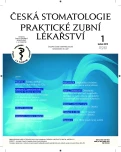Is there a Possibility of Early Diagnosis of Acromegaly by General Practicioner?
Authors:
L. Atanasová 1; J. Horáček 2; R. Slezák 1
Authors‘ workplace:
Stomatologická klinika LF UK a FN, Hradec Králové
1; IV. Interní hematologická klinika LF UK a FN, Hradec Králové
2
Published in:
Česká stomatologie / Praktické zubní lékařství, ročník 113, 2013, 1, s. 20-26
Category:
Review Article
Overview
Introduction, Aim:
Acromegaly is a disease that importantly shortens the life-expectancy without its treatment. Due to the slow and indolent clinical course of acromegaly, the diagnosis is often delayed, making the treatment less successful. As many of the clinical signs may be found in the cranium and orofacial region, we believe that a well-educated and careful dentist can be the first health care worker who voted for acromegaly suspected, and shorten the period the disease onset to its detection and treatment.
Acromegaly is a relatively rare and slowly progressive disease. The disease is caused by pathologically increased production of growth hormone in the period after closure of growth gaps in bones. Hypersecretion of growth hormone is most commonly caused by the anterior pituitary adenoma. The best-known clinical manifestations of the disease outside the orofacial region is overgrowth of the hands and feet. Changes in the intervertebral cartilage cause spine kyphosis. Involvement of articular cartilage is reflected generalized osteoarthritis. Growth cartilage of the larynx leads to a deepening voice. Dangerous are cardiomyopathy with arrhythmias, left ventricular hypertrophy and heart failure. More than half of patients suffer from obstructive sleep apnea. Overproduction of growth hormone leads to insulin resistance with increased risk of secondary diabetes mellitus (approximately 25%). In the craniofacial region growing pituitary tumor may cause headaches, diplopia and loss of visual field. On the radiographs of the skull, including long-distance shots used in orthodontics, can be observed magnificated sella turcica in the sagittal dimension. Thicker lower jaw may be noticeable on the panoramic radiographs. Lower jaw is the most-affected part of the skeleton face. In the oral cavity we observed enlarged tongue and spaced teeth in the lower jaw. Overall mortality is increased about three times in the case of late diagnosis and treatment of acromegaly, survival is reduced by an average of 10 years.
Conclusion:
Early diagnosis and effective treatment, reducing the secretion of growth hormone, usually achieved by a combination of surgery and conservative treatment of acromegaly improves prognosis. The authors offer the contact for consultation of all suspects.
Key words:
acromegaly – cranium – orofacial signs – growth hormone
Sources
1. Çapoglu, I., Yilmaz, A. B., Ünüvar, N., Orbak, R., Aksoy, H., Yesilyurt, H.: Gingival enlargement in acromegaly. Endocrine, roč. 18, 2002, č. 3, s. 207–210.
2. Čáp, J.: Onemocnění hypothalamo-hypofyzární. In Bureš, J., Horáček, J.: Základy vnitřního lékařství, 1. vyd. Praha, Galén, 2003, s. 526–536.
3. Dostálová, S., Šonka, K., Šmahel, Z., Weiss, V., Marek, J.: Cephalometric assessment of cranial abnormalities in patients with acromegaly. J. Cranio-Maxillofac. Surg., roč. 31, 2003, č. 2, s. 80–87.
4. Chanson, P., Salenave, S.: Acromegaly. Orphanet. J. Rare. Dis., roč. 3, 2008, č. 1, článek č. 17.
5. Laskaris, G.: Color atlas of oral diseases. 2nd ed. Stuttgart, New York, Georg Thieme Verlag, 1994, s. 253.
6. Lima, D. L. F., Montenegro, R. M. Jr., Vieira, A. P. G. F., Albano, M. F., Rego, D. M.: Absence of periodontitis in acromegalic patients. Clin. Oral. Invest., roč. 13, 2009, č. 2, s. 165–169.
7. Manetti, L., Bogazzi, F., Brogioni, S., et al.: Submandibular salivary gland volume is increased in patients with acromegaly. Clin. Endocrinol., roč. 57, 2002, č. 1, s. 97–100.
8. Marie, P.: On two cases of acromegaly: marked hypertrophy of the upper and lower limbs and the head. Rev. Med., roč. 6, 1886, s. 297–333.
9. Regezi, J. A., Sciubba, J. J.: Oral patology. Clinical pathologic correlations. 3rd ed. Philadelphia, London, Toronto, Montreal, Sydney, Tokyo, W. B. Saunders Company, 1999, s. 425–427.
10. Sugata, T., Myoken, Y., Tanaka, S.: Acromegaly identified in a patient with a complaint of malocclusion. Oral. Surg. Oral. Med. Oral. Pathol. Oral. Radiol. Endod., roč. 85, 1998, č. 1, s. 44–46.
11. Yagi, T., Kawakami, M., Takada, K.: Surgical orthodontic correction of acromegaly with mandibular prognathism. Angle Orthod., roč. 74, 2004, č. 1, s. 125–131.
Labels
Maxillofacial surgery Orthodontics Dental medicineArticle was published in
Czech Dental Journal

2013 Issue 1
Most read in this issue
- Diagnosis and Treatment Possibilities of Oral Lichen Planus
- The Loss of First Permanent Molar in Young Patients
- Is there a Possibility of Early Diagnosis of Acromegaly by General Practicioner?
- Association between Oral Health Indicators in 13- to 15-years-old Children of ELSPAC Group Brno and Parental Educational Level
